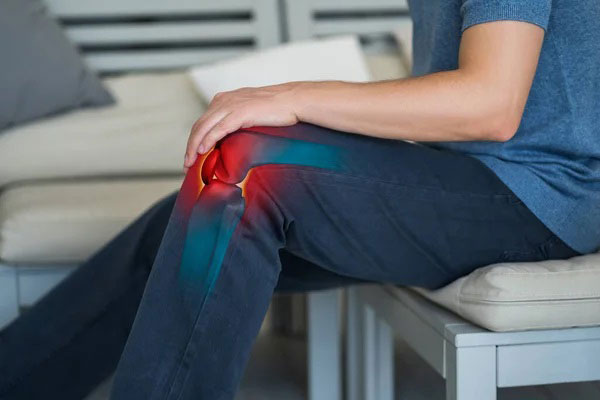Knee Bursitis
The knee joint is one of the strongest joints in our body, and it allows movements that are essential to everyday activities like walking, running, sitting, and standing and supports our body weight. The knee joint is formed with three bones: the femur, tibia, and patella, which are connected to each other and to muscles by various connective tissues (tendons and ligaments). The knee joint area also has numerous bursae (thin sacs containing natural lubricant) and fat pads to reduce friction between bones, ligaments, skin, and the kneecap.
What is knee bursitis?
It is inflammation of the small fluid-filled sacs (bursae) situated near the knee joint that will limit knee mobility and cause pain. This usually happens with injuries or repetitive use of joints while running, kneeling, etc. Though bursae inflammation can occur in any part of the knee, it commonly occurs over the kneecap (prepatellar bursitis) or on the inner side of the knee below the joint.

What are the symptoms of knee bursitis?
The symptoms of knee bursitis differ based on which bursa is affected and the cause of inflammation. The symptoms will start gradually and can get worse over time.
The affected area will become swollen, tender, and warm, with mild pain when you apply less pressure or even when resting the leg. As the condition persists, the pain may increase, followed by stiffness and difficulty doing regular knee movements. The swelling will be visible, along with redness and puffing.
What are the causes and risk factors for knee bursitis?
Knee bursitis happens when the bursa near your knee joint is filled with extra fluid and becomes inflamed. This can be caused by:
- Frequent and sustained pressure on the knee, such as kneeling on hard surfaces
- Overuse of knee for intense physical activities like football, volleyball, etc.
- A direct blow to your knee
- Any kind of bacterial infection of the bursa caused by injuries that break the skin like insect bite, scrape, or puncture wounds.
- Complications from conditions like osteoarthritis, rheumatoid arthritis or gout.
The risk of developing knee bursitis is more for:
- Active sportspersons who are exposed to direct hits and falls during the sports like wrestling, football, etc.
- Overweight individuals and those with conditions like osteoporosis, which increases the pressure on the knee.
- Workers like plumbers, carpet layers, and garden workers who kneel for long periods while working.
How knee bursitis is diagnosed?
Your doctor will do a physical examination by inspecting the affected knee and comparing it to your healthy knee. A diagnostic test called aspiration is also performed, where a sample of fluid is collected from the bursa to check the chances of infection. Imaging tests like X-rays, MRI scans, and ultrasounds are also recommended to confirm the diagnosis and assess the severity of the condition.
What are the treatment methods for knee bursitis?
The treatment approaches depend on the cause and severity of the inflammation in the bursa. It also depends on whether the inflammation is infected or not. Treatment methods for knee bursitis aim to provide relief from the symptoms associated with the condition.
Non-surgical treatments are effective when the inflammation in the bursae is not severe or infected. This includes lifestyle modification, home remedies, and medication followed by physiotherapy; some of these are discussed below.
- Rest can significantly help prevent symptoms from getting worse. Avoiding activities that put pressure on the knee joints and substituting them with low-impact exercises like cycling will reduce the symptoms associated with knee bursitis.
- Applying ice at regular intervals will reduce swelling on the knee (cold compression).
- Keeping your affected leg in an elevated position and using compression wraps will help reduce swelling.
- Medications such as non-steroidal anti-inflammatory drugs (NSAIDs) like naproxen and ibuprofen may relieve pain and control inflammation.
Exercises or physical therapy under the guidance of a physical therapist can help improve the flexibility and strength of muscles and reduce the risk of reoccurrence of this condition.
If these measures do not help, your doctor may recommend surgical and minimally invasive procedures to control the condition. These methods include:
- Corticosteroid injection: Injecting a corticosteroid drug into an affected bursa will help reduce inflammation, pain, and swelling on the affected area.
- Aspiration: To reduce excess fluid and treat inflammation, your surgeon may aspirate the bursa, where a needle is inserted into the bursa to draw the fluid. The collected fluid is sent to a laboratory for further analysis. If the fluid is infected, then antibiotics are prescribed to treat the infection.
- Surgery: In severe or chronic conditions where the infection does not respond to antibiotics alone, surgical drainage of fluids is performed, and in rare cases, the bursa is removed surgically.
How can one prevent the chances of knee bursitis and its reoccurrence?
One can avoid knee bursitis or prevent its recurrence by doing some lifestyle modifications, like:
- Taking regular breaks to stretch your legs and rest while doing activities that cause stress to knee joints.
- Wearing kneepads while participating in sports activities to protect your knees.
- Maintaining a healthy body weight to reduce the pressure on the knee joint.
- Minimizing exercises like squatting that increase the force on the knee joints.
- Bending your knees while lifting anything heavy as it may cause stress on the bursae in your hips and knee.